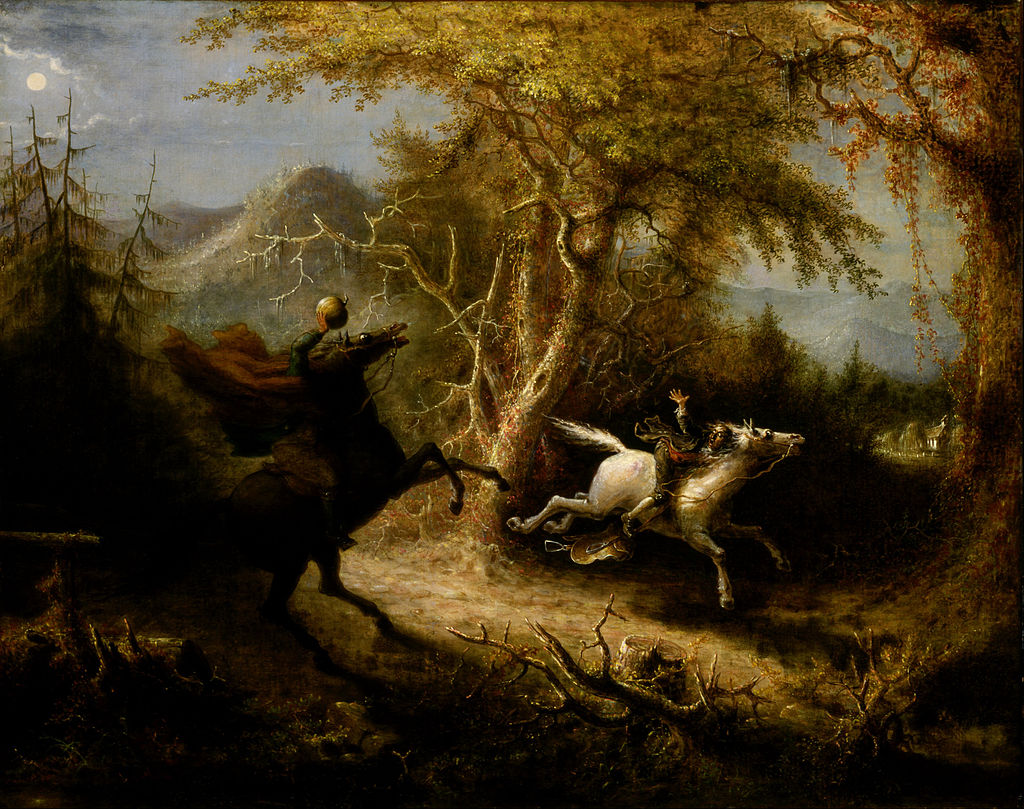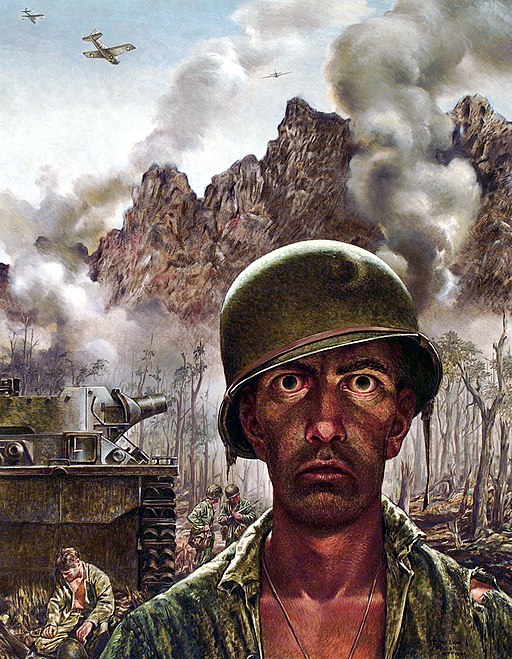
“The Headless Horseman Pursuing Ichabod Crane” by John Quidor depicts a scene from Washington Irving’s 1820 short story “The Legend of Sleepy Hollow.”
The schoolmaster Ichabod Crane is fleeing on a white horse, pursued by the Headless Horseman on a black horse. The Headless Horseman is holding a pumpkin, which he is preparing to throw at Crane.
Visible in the background is the Old Dutch Church of Sleepy Hollow and the adjacent Cemetery, and the full moon.
The painting is one of several by John Quidor based on scenes from Irving’s written works about Dutch New York.
“The Legend of Sleepy Hollow” is among the earliest examples of American fiction with enduring popularity.
The story is mainly remembered during Halloween as the character who is known as the “Headless Horseman.”
The Legend of Sleepy Hollow
“The Legend of Sleepy Hollow” is a gothic story by Washington Irving, first published in 1820. The story is set in 1790 in the countryside around the Dutch settlement near New York, in a secluded glen known as Sleepy Hollow.
Sleepy Hollow is renowned for its ghosts that pervade the imaginations of its inhabitants.
The most infamous apparition is the Headless Horseman, the ghost of a trooper whose head had been shot off by a cannonball during the Revolution, and who rides in nightly quests for his head.
The “Legend” relates the tale of Ichabod Crane, a superstitious schoolmaster from Connecticut, who, on one night, encounters a cloaked rider at an intersection near a menacing swamp.
Ichabod is horrified to discover that the stranger’s head, in the form of a Jack-o’-Lantern, is not on his shoulders, but on his saddle.
This vision resulted in a frenzied race to the bridge adjacent to the Old Dutch Burying Ground to escape the specter.
Crane eventually crosses the bridge, that according to legend, the ghost could not cross. He crossed the bridge ahead of the ghoul; however, the pumpkin head is hurled directly at Ichabod as he makes it across the bridge.
Ichabod attempts to dodge, but the pumpkin missile strikes his head, and it sends him off his horse into the ground.
The next morning, Ichabod has mysteriously disappeared. All that remains are his hat, his horse’s trampled saddle, and a mysterious shattered pumpkin.
Although the true nature of Ichabod’s disappearance that night are left open to the reader’s interpretation, a legend develops around his disappearance and sightings of his melancholy spirit.
The narrator concludes the story by stating that the old Dutch wives continue to promote the belief that Ichabod was spirited away by supernatural means.
Washington Irving
Washington Irving (1783 – 1859) was an American short-story writer, essayist, biographer, historian, and diplomat of the early 19th century. He is best known for his short stories “Rip Van Winkle” (1819) and “The Legend of Sleepy Hollow” (1820).
Irving was born in New York and later moved to England for the family business in 1815, where he achieved fame with his writings.
Irving was one of the first American writers to earn acclaim in Europe, and he encouraged other American authors such as Nathaniel Hawthorne, Henry Wadsworth Longfellow, Herman Melville, and Edgar Allan Poe.
He was also admired by several British writers, including Lord Byron and Charles Dickens. He advocated for writing as a legitimate profession and argued for stronger laws to protect American writers from copyright infringement.
John Quidor
John Quidor (1801 – 1881) was a painter of historical and literary subjects of which about 35 known canvases have survived.
Most of his compositions were based on Washington Irving’s stories about Dutch New York.
He was inspired by the Hudson Valley and influenced by English painters such as William Hogarth, Joseph Wright of Derby, and George Morland.
The Headless Horseman Pursuing Ichabod Crane
- Title: The Headless Horseman Pursuing Ichabod Crane
- Artist: John Quidor
- Year: 1858
- Medium: Oil on canvas
- Dimensions Height: 682.75 mm (26.87 in); Width: 860.55 mm (33.87 in)
- Museum: Smithsonian American Art Museum
John Quidor
- Name: John Quidor
- Born: 1801, Tappan, New York
- Died: 1881 (aged 80), Jersey City, New Jersey
- Nationality: American
- Notable works:
- The Headless Horseman Pursuing Ichabod Crane
Ichabod Crane & the Headless Horseman
A Tour of the Smithsonian American Art Museum
- “Skating in Central Park” by Agnes Tait
- “Buffalo Hunt on the Southwestern Prairies” by John Mix Stanley
- “Surrender of a Confederate Soldier” by Julian Scott
- “Westward the Course of Empire Takes Its Way” by Emanuel Leutze
- “The Headless Horseman Pursuing Ichabod Crane” by John Quidor
Sleepy Hallow Painting
A Tour of Washington, D.C. Museums
- National Gallery of Art
- National Museum of American History
- National Air and Space Museum
- National Museum of African American History and Culture
- National Museum of Natural History
- National Portrait Gallery
- Smithsonian American Art Museum
- The Phillips Collection
- Hirshhorn Museum and Sculpture Garden
- International Spy Museum
- National Museum of Women in the Arts
- United States Holocaust Memorial Museum
The Headless Horseman Story
A Tour of New York Museums
- Metropolitan Museum of Art – MET
- Museum of Modern Art, NYC
- Intrepid, Sea, Air & Space Museum
- Neue Galerie New York
- The Cloisters
- Solomon R. Guggenheim Museum
- American Museum of Natural History
- Museum of the City of New York
- New-York Historical Society
- Frick Collection
- Met Breuer
- Rubin Museum of Art
- Whitney Museum of American Art
- Brooklyn Museum
SLEEPY HOLLOW
~~~
“I am always at a loss to know how much to believe of my own stories.”
– Washington Irving
~~~
Photo Credit: 1) John Quidor / Public domain
Popular this Week








 Sponsor your Favorite Page
Sponsor your Favorite Page SEARCH Search for: Search Follow UsJoin – The JOM Membership Program
Sponsor a Masterpiece with YOUR NAME CHOICE for $5
Share this:
- Tweet
